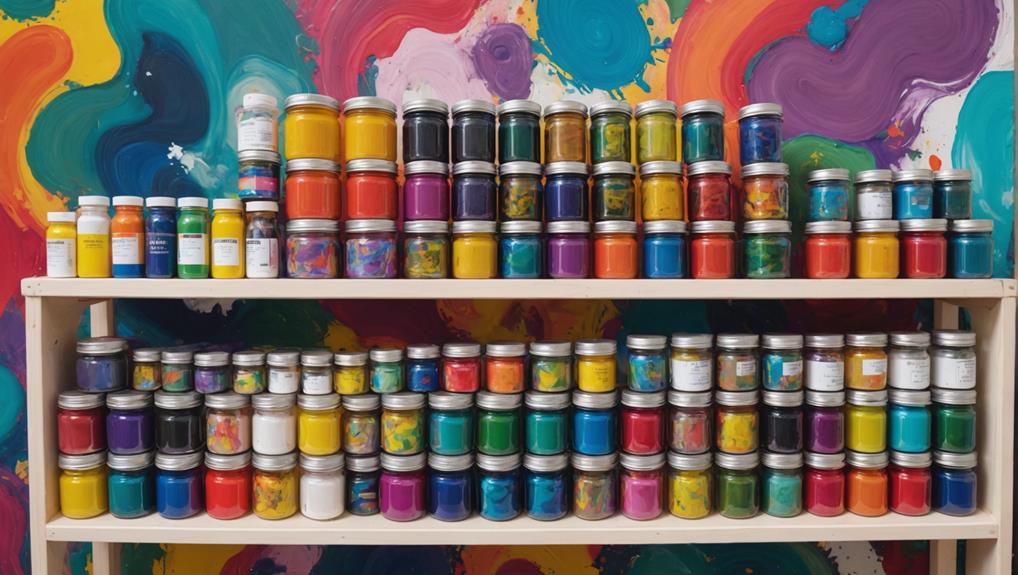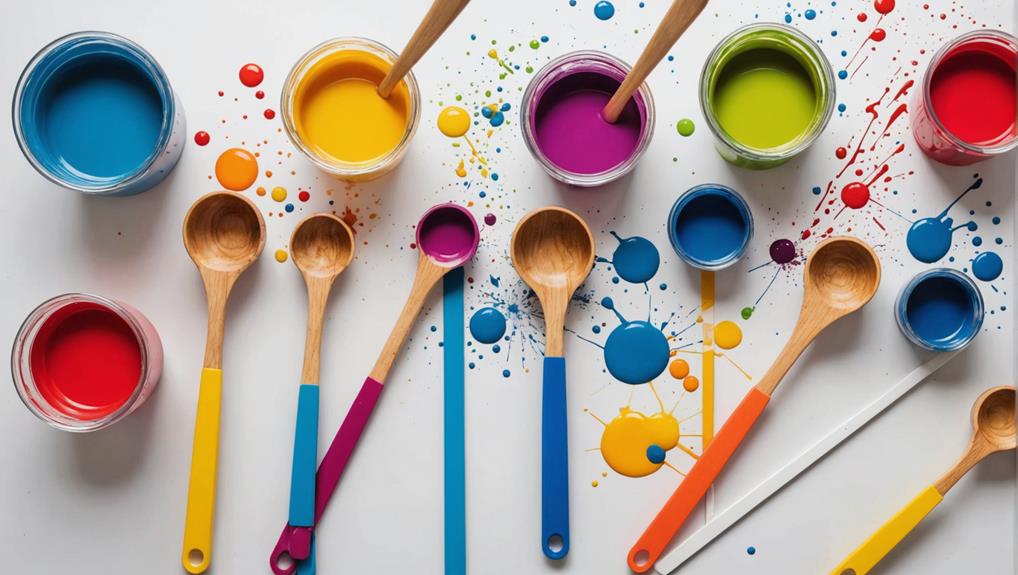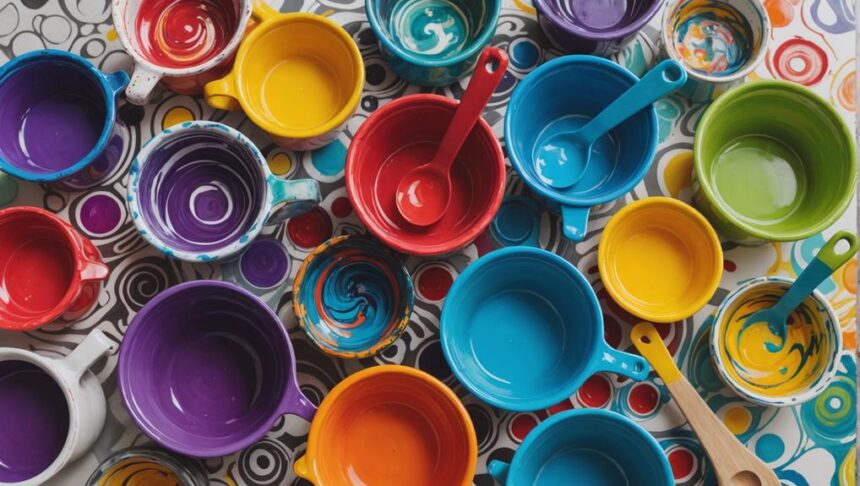When you’re diving into fluid art, the right mixing and measuring tools are your best friends! Start with silicone mixing sticks or even lollipop sticks for a fun, budget-friendly twist. Use paper cups for small mixes or silicone cups with spouts for precise pouring. Measuring cups and jugs are essential for getting those perfect paint ratios, while airtight containers guarantee leftovers stay fresh. Don’t forget to protect your workspace with disposable mats or plastic bags to keep spills in check! These tools make fluid art smoother and more enjoyable—there’s much more to explore about making your art flow just right.
Key Takeaways
- Silicone mixing sticks are flexible and easy to clean, enhancing convenience for fluid art projects.
- Measuring jugs are essential for combining larger quantities of paint and pouring mediums accurately.
- Silicone mixing bowls, starting at £6.97, are stain-resistant and easy to clean.
- Quality pouring mediums like Flowtrol ensure optimal paint flow and consistency.
Essential Equipment
Guaranteeing a successful fluid art project begins with assembling the essential equipment, starting with a level surface to create a stable work environment. Imagine setting up on a wobbly table—disaster! Kitchen counters or specially designed workbenches are great options. Use a spirit level to verify your surface is perfectly flat, avoiding any paint mishaps.
Next, think about protecting your workspace. Fluid art can get messy, so disposable mats or dust sheets are lifesavers, catching those inevitable spills and drips. Trust me, your furniture will thank you!
For the actual painting, pre-primed canvases are your best bet. They give the paint a good surface to stick to, helping prevent issues that come with cheaper materials.
Now, let’s talk about mixing. Silicone mixing sticks are fantastic—they’re reusable and easy to clean. You’ll need various vessels like paper cups and silicone cups with spouts to mix your paints.
Measuring jugs are essential when you’re working with larger quantities of pouring medium and paint. They make sure you get the right mixing consistency every time, which is key for smooth color blending.
Surface Preparation
Preparing your workspace meticulously sets the foundation for a successful fluid art project. The first step is to guarantee surface leveling, which is vital for fluid art. A flat surface like a kitchen counter, table, or workbench can help maintain accurate paint flow and avoid unwanted drip patterns. Don’t overlook this step; an unlevel surface can ruin your masterpiece.
Next, think about protective coverings. Fluid art can get messy, so using plastic bags, dust sheets, or disposable mats to cover your work area will save you a lot of cleanup time. It’s much easier to throw away a plastic sheet than to scrub dried paint off your table.
When it comes to your canvas, pre-primed ones are your best bet. Just make sure they’re of decent quality. Stabilizing your canvas is equally important; giant push pins can keep it from warping or moving while it dries.
Paint Selection
Selecting the right paint is fundamental for achieving the desired effects in fluid art. The type of paint you choose can greatly impact your artwork’s outcome, so it’s important to understand a few key concepts.
First, let’s talk about color psychology — the way colors can influence emotions and perceptions. Using bold primary colors can evoke excitement and energy, while softer pastels might create a calming effect. Understanding these principles helps you make more intentional choices in your art.
Another significant factor is paint viscosity, or how thick or thin the paint is. High-viscosity paints are thicker, providing more texture and stability, ideal for creating well-defined cells and intricate details. Conversely, low-viscosity paints are thinner and flow more easily, perfect for achieving smooth, flowing patterns.
For beginners, starting with basic colors such as black and white is fundamental. These colors provide a foundation for creating contrast. Brands like Amsterdam, PBO, and Windsor & Newton are recommended for their reliable and consistent performance.
Instead of buying every available hue, beginning with primary and secondary colors is more cost-effective and encourages learning essential color mixing skills. Additionally, understanding the color wheel is crucial for mastering color theory.
Mixing Supplies
Mixing supplies are essential to getting your fluid art just right!
Silicone mixing sticks are fantastic because they’re flexible and easy to clean, but if you’re in a pinch, lollipop sticks work too.
You’ll also need a variety of mixing vessels like paper cups for small batches and silicone cups with spouts for precision.
For larger quantities, measuring jugs are necessary to guarantee your paint-to-pouring medium ratios are spot on.
Essential Mixing Tools
An array of essential mixing tools can considerably enhance the efficiency and quality of your fluid art projects. Among these tools, different stick types play a pivotal role in your mixing techniques. Silicone mixing sticks are highly recommended due to their flexibility and ease of cleaning. On the other hand, lollipop sticks offer a budget-friendly alternative without compromising on functionality.
To keep your fluid art process smooth, various vessels like paper cups and silicone cups with spouts are indispensable. These cups enable accurate mixing and pouring of paint and pouring mediums, ensuring your artwork maintains consistency. Additionally, for those working with larger quantities, measuring jugs are a must-have to achieve precise ratios and uniformity.
Investing in quality pouring mediums, such as Flowtrol or PBO Studio Acrylics, can considerably enhance the flow and consistency of your paint. For instance, Liquid Pouring Medium, priced around £25 for 946ml, is a popular choice among artists.
| Tool | Description |
|---|---|
| Silicone Mixing Sticks | Flexible and easy to clean |
| Lollipop Sticks | Budget-friendly alternative |
| Paper Cups | Useful for accurate mixing and pouring |
| Silicone Cups with Spouts | Ideal for controlled pouring and reducing spills |
To preserve leftover paint, sealed containers like Tupperware are excellent for maintaining the integrity of mixed paint over extended periods.
Paint Measuring Techniques
To achieve precise paint mixtures, employing accurate measuring techniques is essential for the success of your fluid art projects. Using the right tools can make a world of difference. For instance, paper cups or silicone cups with spouts are great for measuring smaller quantities of paint and pouring mediums. These vessels allow for precise control, which is important when you’re aiming for a specific paint viscosity.
When working with larger quantities, measuring jugs are indispensable. They guarantee that your paint and pouring medium ratios remain consistent, which is key for achieving the perfect color blending. Mixing sticks also play an important role—silicone sticks are particularly useful as they provide better control and minimize paint waste compared to wooden ones.
Moreover, understanding the color wheel can greatly enhance your ability to blend colors effectively. This helps you know exactly how much of each color to mix to achieve your desired hue.
For beginners looking to save on costs, PVA glue is a budget-friendly pouring medium. It’s easy to measure and mix, priced around £10 for 5 liters.
Measuring Tools

Accurate measurements are vital in fluid art, making measuring tools indispensable for achieving desired paint consistency and effects. Employing precise measuring techniques is essential to guarantee volume accuracy, which greatly influences the final artwork’s outcome.
One of the most important tools in this process is the measuring jug. These jugs are perfect for combining larger quantities of pouring medium and paint, ensuring the right mix for fluid art techniques. Their capacity to measure substantial volumes accurately reduces inconsistencies and helps in maintaining the desired flow and texture.
In addition to jugs, various sizes of measuring cups are invaluable for determining exact amounts of paint and mediums. These graduated cups allow artists to mix multiple colors with precision, ensuring harmonious and vibrant effects in their work.
For smaller quantities, disposable paper cups offer a cost-effective and hassle-free solution, eliminating the need for cleaning and providing convenience.
Silicone mixing bowls, starting from £6.97, are another great option. They are stain-resistant and ideal for mixing paints. Together, these tools help fluid artists achieve consistency, minimize waste, and improve overall results, showcasing the importance of precise measuring in the creation of stunning fluid art.
Pouring Mediums
Pouring mediums are essential components in fluid art, determining the consistency and flow important for achieving desired artistic effects. These magical concoctions turn your acrylic paints into perfect partners for various pouring techniques.
Popular options like Flowtrol and PBO Studio Acrylics are beloved for their reliable performance, but they do come at a price—around £25 for 946ml of Liquid Pouring Medium.
For those just starting out, PVA glue is a budget-friendly alternative, costing about £10 for 5 liters. When mixed with acrylic paints, it creates a decent pouring medium, albeit with slightly different results. The key to success lies in medium comparisons—experimenting with different brands and types to find what works best for your artistic vision.
Accurate measurement is essential to maintain the ideal paint consistency. Measuring jugs are your best friends here, especially for larger quantities.
Stirring is another important step, and silicone mixing sticks come to the rescue. They mix thoroughly without introducing pesky air bubbles that can ruin your masterpiece.
Storage Solutions

Proper storage solutions are essential for preserving the quality and usability of your mixed paints and mediums, ensuring that your fluid art materials remain in ideal condition. Paint longevity is vital, and using the right container types can make a significant difference. Tupperware or similar airtight containers are perfect for storing leftover paint, keeping it usable for extended periods. For short-term storage, covering mixed paint with cling film can help maintain its consistency and prevent it from drying out.
To prevent paint from splitting, it’s important to store your containers in a stable temperature environment. Avoid placing them in cold places, as fluctuating temperatures can negatively affect the paint’s quality. Here’s a handy table to summarize these storage tips:
| Storage Tip | Benefit |
|---|---|
| Airtight containers | Keeps paint usable for longer periods |
| Cling film for short-term | Maintains consistency and prevents drying out |
| Stable temperature environment | Prevents paint from splitting |
Cleanup Tips
Efficient cleanup practices are vital for maintaining a tidy and functional workspace in fluid art. Utilizing sustainable materials, like biodegradable wet wipes, is a smart way to clean up paint spills and tools without harming the environment. Keeping a roll of kitchen paper handy can also be a lifesaver, as it allows for quick swipes to remove excess paint and keep surfaces clean.
To keep your workspace organized, cover mixed paint with cling film for short-term storage. This prevents the paint from drying out and makes cleanup easier when you’re ready to use it again. Regularly changing the protective coverings on your work surface is important; it helps avoid paint buildup and guarantees you always have a clean area to work on your next masterpiece.
Avoiding jewelry and old clothes while painting is a simple tip that can greatly reduce cleanup efforts. Paint can easily ruin these items, and minimizing the risk can save you a lot of hassle.
Efficient cleanup not only keeps your space neat but also enhances your creative process, allowing you to focus more on your art and less on the mess.
Specialty Tools
In addition to effective cleanup practices, utilizing specialty tools can greatly enhance the quality and intricacy of your fluid art creations.
One essential tool is the BIG Fluid Art Palette Knife, available from just £8.48. These knives are perfect for applying palette knife techniques, allowing artists to create dynamic textures and effects in their work. They come in multiple sizes, so you can always find the right one for your specific needs and artistic vision.
Another indispensable tool is the Paint & Pigment Blender, priced at £10.51. This blender is important for those who want to master blending color strategies. It guarantees that your colors are mixed smoothly and consistently, which is fundamental to achieving vibrant and harmonious results in your fluid art pieces. The right blending tools can make a significant difference in the final outcome of your work.
Pouring tools designed specifically for fluid art help control the flow and application of paint. They guarantee precise and intentional results, which is essential for any fluid artist.
Mixing tools optimized for pigment blending are also important for achieving the right consistency and color saturation, making them indispensable in the fluid art creation process.
Additional Tips
For enhancing the quality of your fluid art, consider the following additional tips to optimize your process and achieve consistently impressive results. Understanding color theory is vital; experimenting with complementary and analogous color schemes can uplift your artwork. Using silicone mixing sticks for stirring paint guarantees a smooth blend, while lollipop sticks offer a handy, budget-friendly alternative.
Texture techniques add depth to your pieces. Try varying the consistency of your paints by adjusting the ratio of pouring medium to paint. This can create intriguing textures and visual interest. Silicone cups with spouts facilitate controlled pouring and minimal mess, essential for intricate designs. Measuring jugs are indispensable for accuracy when combining larger quantities of mediums and paints.
Regularly document your techniques and outcomes. Maintaining a record helps refine your approach and identifies what works best. Additionally, consider using PVA glue as a cost-effective pouring medium, especially if you are a beginner. It is priced around £10 for 5 liters and can provide satisfactory results.
Here is a quick reference table for these additional tips:
| Tip | Benefit |
|---|---|
| Understand color theory | Enhances visual appeal |
| Use silicone mixing sticks | Guarantees smooth paint blending |
| Experiment with texture | Adds depth and interest to artwork |
| Utilize silicone cups | Facilitates controlled pouring |
| Document your process | Helps refine techniques and improve results |
Budget Considerations

When starting on fluid art, balancing cost with quality is vital to secure both affordability and satisfactory results.
For example, silicone mixing bowls are a fantastic cost-effective alternative, priced at around £6.97, and they can be reused across various projects. This makes them a smart choice for those looking to stretch their budget without compromising on functionality.
Accurate paint measurements are essential for achieving the right consistency, and this is where investing in measuring jugs really pays off. While it might seem like a small expense, these tools guarantee you maintain consistent paint-to-pouring medium ratios, which helps avoid waste and enhances the quality of your art.
Silicone mixing sticks are another cost-effective option worth considering. Unlike disposable utensils, these sticks are easy to clean and reusable, providing both convenience and savings over time.
For those just beginning, PVA glue is an affordable pouring medium priced at approximately £10 for 5 liters. This allows for plenty of experimentation without a hefty investment, making it an excellent choice for newcomers.
Frequently Asked Questions
What Ratio Do You Mix Fluid Art With?
The mixing ratio in fluid art typically varies based on desired effects, with 1:1 for general use, 2:1 for vibrant cells, and 1:2 for thicker paints. Experimenting with mixing techniques guarantees ideal fluid consistency.
How to Mix Paint for Pouring Art?
To mix paint for pouring art, achieve the ideal paint consistency by combining acrylic paint with a pouring medium. Employ precise pouring techniques to guarantee smooth, even layers. Maintaining consistent ratios enhances the fluidity and flow of the paint.
How to Measure Acrylic Paint for Mixing?
To measure acrylic paint for mixing, employ precise measuring techniques such as using measuring jugs or digital scales. This guarantees ideal paint consistency, essential for achieving desired effects and maintaining reproducibility in fluid art projects.
What Tool to Use to Mix Acrylic Paint?
For achieving ideal paint consistency and effective mixing techniques, silicone mixing sticks are recommended due to their durability and ease of cleaning. Lollipop sticks are suitable for small batches, while larger quantities benefit from dedicated measuring jugs.
Conclusion
The tools and techniques in fluid art are crucial for achieving desired outcomes.
Proper surface preparation, paint selection, and appropriate mixing and measuring supplies considerably influence the final artwork.
Effective cleanup and the use of specialty tools enhance the creative process and guarantee longevity of equipment.
Budget considerations play an essential role in selecting the right tools, making fluid art accessible to a broader audience.
Mastery of these elements contributes to successful and satisfying artistic endeavors.


Leave a Reply